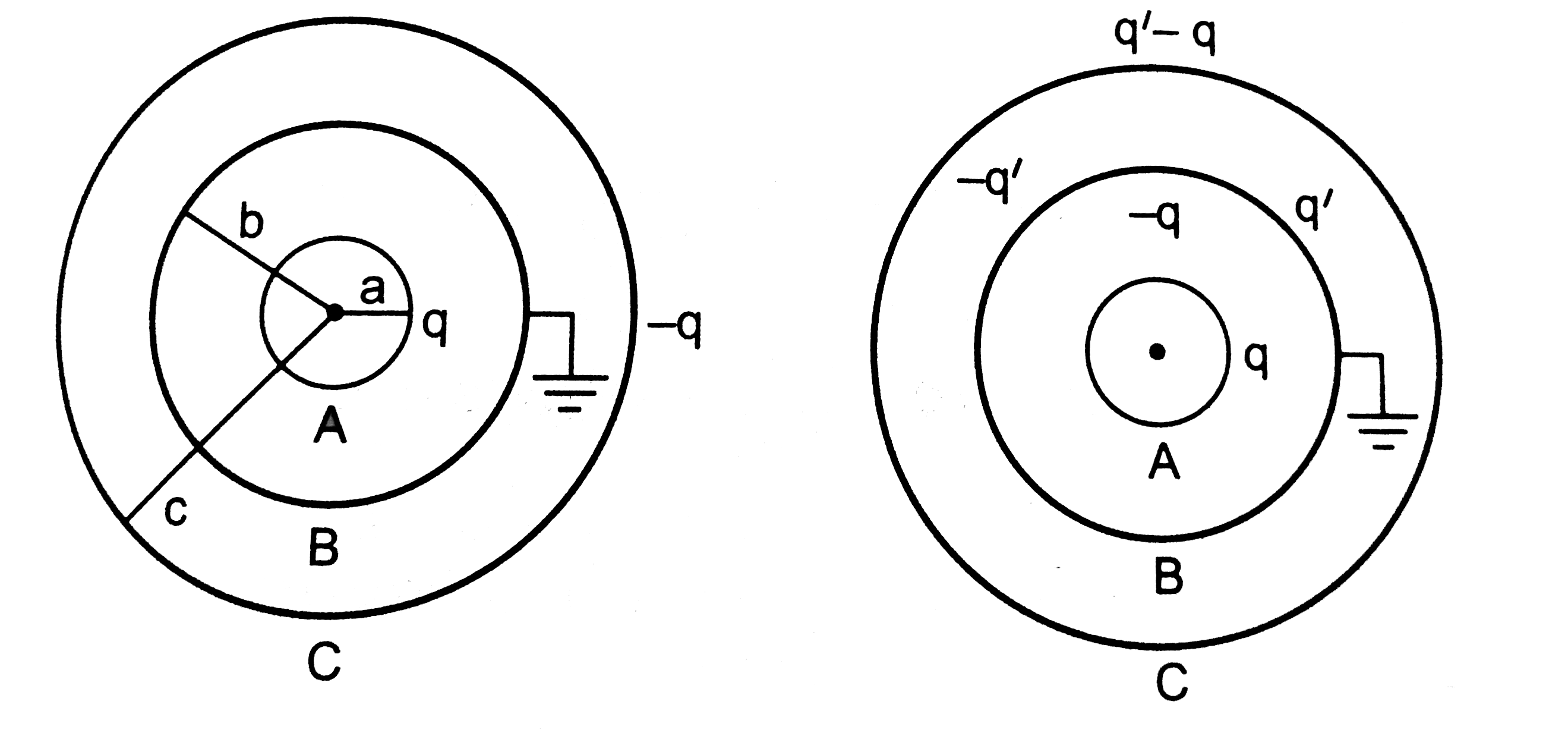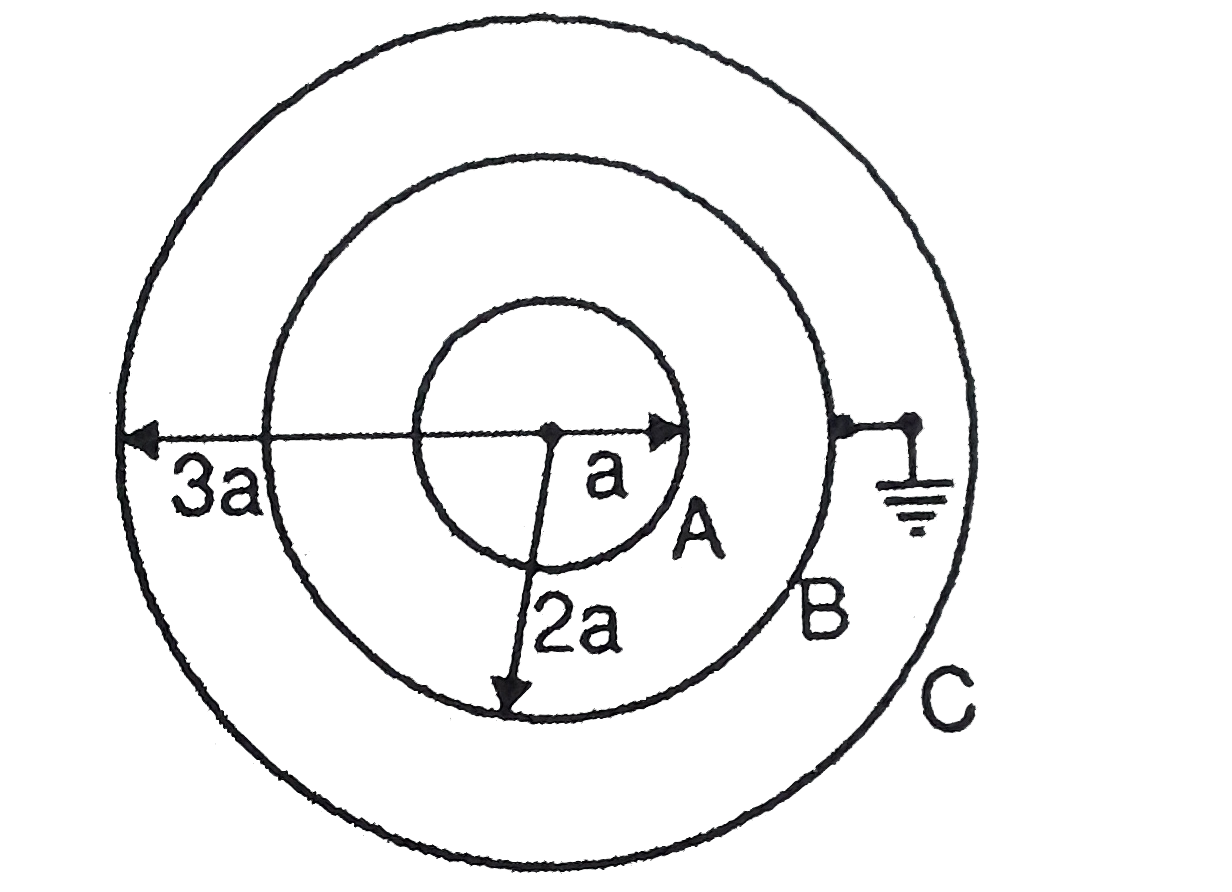Four concentric conducting spherical shells A, B, C and D of radii a, 2a, 3a and 4a respectively. Shell B and D are given charges q and −q respectively. If shell C is grounded then potential difference (VA — VC) is
A. q12πε0a
B. q6πε0a
C. q24πε0a
D. q16πε0a
To solve the problem, we need to find the potential difference VA−VC for the given concentric conducting spherical shells. Let's break this down step by step.
Step 1: Understand the Configuration
We have four concentric spherical shells:
- Shell A with radius a
- Shell B with radius 2a (charged with +q)
- Shell C with radius 3a (grounded)
- Shell D with radius 4a (charged with −q)
Step 2: Determine the Potential at Shell C
Since shell C is grounded, its potential VC is defined to be 0.
Step 3: Calculate the Potential at Shell A
The potential VA at shell A due to the charges on shells B and D can be calculated using the formula for the potential due to a charged spherical shell:
V=k⋅Qr
where k is Coulomb's constant, Q is the charge, and r is the distance from the center to the shell.
The potential at shell A due to shell B (which has charge +q) is:
VA,B=k⋅qa
The potential at shell A due to shell D (which has charge −q) is:
VA,D=k⋅−q4a
Step 4: Combine the Potentials
The total potential at shell A is the sum of the potentials due to shells B and D:
VA=VA,B+VA,D=k⋅qa−k⋅q4a
VA=k⋅(qa−q4a)=k⋅(4q4a−q4a)=k⋅3q4a
Step 5: Calculate the Potential Difference
Now that we have VA and VC:
VC=0(since shell C is grounded)
Thus, the potential difference VA−VC is:
VA−VC=VA−0=VA=k⋅3q4a
Final Result
The potential difference VA−VC is:
VA−VC=k⋅3q4a
We have four concentric spherical shells:
- Shell A with radius a
- Shell B with radius 2a (charged with +q)
- Shell C with radius 3a (grounded)
- Shell D with radius 4a (charged with −q)
Since shell C is grounded, its potential VC is defined to be 0.
The potential VA at shell A due to the charges on shells B and D can be calculated using the formula for the potential due to a charged spherical shell:
V=k⋅Qr
where k is Coulomb's constant, Q is the charge, and r is the distance from the center to the shell.
VA,B=k⋅qa
VA,D=k⋅−q4a
The total potential at shell A is the sum of the potentials due to shells B and D:
VA=VA,B+VA,D=k⋅qa−k⋅q4a
VA=k⋅(qa−q4a)=k⋅(4q4a−q4a)=k⋅3q4a
Now that we have VA and VC:
VC=0(since shell C is grounded)
Thus, the potential difference VA−VC is:
VA−VC=VA−0=VA=k⋅3q4a
The potential difference VA−VC is:
VA−VC=k⋅3q4a
Similar Questions
There are four concentric shells A,B, C and D of radii a,2a,3a and 4a respectively. Shells B and D are given charges +q and −q respectively. Shell C is now earthed. The potential difference VA−VC is k=(14πε0)
View SolutionThere are four concentric shells A,B, C and D of radii a,2a,3a and 4a respectively. Shells B and D are given charges +q and −q respectively. Shell C is now earthed. The potential difference VA−VC is k=(14πε0)
View SolutionThere are four concentric shells A,B, C and D of radii a,2a,3a and 4a respectively. Shells B and D are given charges +q and −q respectively. Shell C is now earthed. The potential difference VA−VC is k=(14πε0)
View SolutionThere are four concentric shells A,B, C and D of radii a,2a,3a and 4a respectively. Shells B and D are given charges +q and −q respectively. Shell C is now earthed. The potential difference VA−VC is k=(14πε0)
View SolutionFigure shows three concentric thin spherical shells A, B and C of radii a, b, and c. The shells A and C are given charge q and -q, respectively, and shell B is earthed. Then,
View SolutionFigure shows three concentric thin spherical shells A, B and C of radii a, b and c respectively. The shells A and C are given charges q and -q respectively and the shell B is earthed. Find the charges appearing on the surfaces of B and C.

View SolutionFigure shows three concentric thin spherical shells A, B and C of radii a, b and c respectively. The shells A and C are given charges q and -q respectively and the shell B is earthed. Find the charges appearing on the surfaces of B and C.

View SolutionThere are two concentric conducting spherical shells of radius rA and rB respectively (rB=2rA). If the inner shell is given a charge Q and outer shell is given a charge 2Q, then the potential difference between the surfaces of the shells will be K=14πε0
View SolutionTwo concentric conducting shells of radii R and 2R are having charges Q and -2Q respectively.In a region r
View SolutionFigure shows a system of three concentric metal shells, A, B and C with radii a, 2a and 3a respectively. Shell B is earthed and shell C is given a charge Q. Now if shell C is connected to shell A, then find the final charge on the shell B

View Solution
